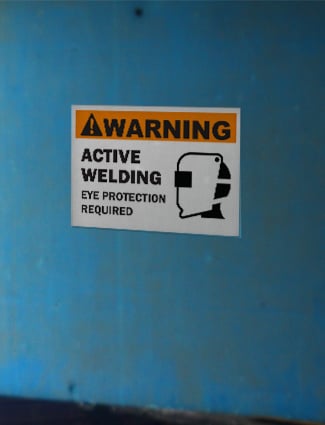How to Avoid Three Top Welding Injuries

Welding is vital to all industries. The craft of manipulating materials that have novel compositions using electric arcs or oxyfuel can be physically demanding and risky. Last week in Portland, Oregon, welders could be seen aboard large snooper cranes while they were making repairs along the steel casting sections of a suspended bridge. Flying metal particles, extreme temperatures, and working with chemicals are just a few of the health and safety risks welders face. Workplaces and their welding workers should be aware of common injuries and know how to take precautions to help avoid them.
Dangers in Welding
There are at least a half million welders in the United States. The Occupational Safety and Health Administration has general requirements regarding welding safety in OSHA 1910.252. In reviewing 2017 OSHA injury data, only 22 incidents of injury from welding were listed as being reported. Among the top injuries that occur from welding, most occur in relation to the eyes. The National Institute for Occupational Safety and Health reports about 2,000 workers daily sustain a medically treated eye injury. However, welding work can also damage ears, lungs, and even the brain. Here are a few common welding injuries and how to protect workers:

Eye Injuries: Among the most common work safety concerns for welders are eye damage. Ultraviolet and infrared light from a welding arc can cause what is called 'Welder's flash' or ?arc eye.' UV burns the eye, and it doesn't always affect the eyes right away. The radiation from infrared light is painful as it scorches the retina. Welders should keep a proper distance away from an arc while working. Prevent sparks and hot metal flecks from getting into the eyes by using proper personal protective equipment such as goggles or a welding hood that meet ANSI Z87.1 requirements. The shade on the welding hood can limit light exposure to the eyes.
Hearing damage: Besides enduring at least eight hours a day of loud noises, particles can penetrate ear canals. Minimize hearing dangers by wearing earplugs or earmuffs. Employers can also put up sound barriers to help limit working area noises. OSHA has requirements for establishing limits on workplace noise. Workers should have their hearing checked regularly.
Breathing dangers: Workers should be aware of the dangers from inhaling welding fumes that come from working with paint, wire, chemicals, and smoke. If not properly protected, breathing these fumes and other particles can cause disorientation, and they can severely damage the lungs. Debris can cause even more physical destruction if it travels up the nose and on to the brain. Always use proper ventilation in welding work areas, and be particularly mindful in confined spaces. Respirators can also help protect against inhalation of hazardous substances.
These are only a few of the job hazards welders face each day that come with hot work. After all, they are working with heat, and fires or burns can happen at any time. In oxyfuel welding, because the work requires use of flammable materials, workplaces should follow protocols for chemical labeling. Repetitive motions and lifting heavy items can also cause injury if not conducted in a safe working manner.
Spark Conversations on Safety
With the unique needs of the job, welders should still follow industry, company, and personal safety guidelines. Management can support workers by ensuring safety controls are available and in their proper place, such as a well-stocked and organized PPE station. Provide information and instructions in the working environment using visual communication that includes floor marking and safety signs and labels.
Related Resources

IIPP (Injury and Illness Prevention Programs)
An injury and illness prevention program (IIPP), has been established to help employers identify and fix ...
Read
Understand Arc Flash and the Shocking Truth About Electrical Injuries
What Are Arc Flash Injuries? Arc flash injuries occur when an electrical current leaves its intended path and ...
Read
Re-evaluate Electrical Work Performance
Electrical work is dangerous and causes numerous injuries and deaths per year. Workplaces can take the time ...
Read.png)





